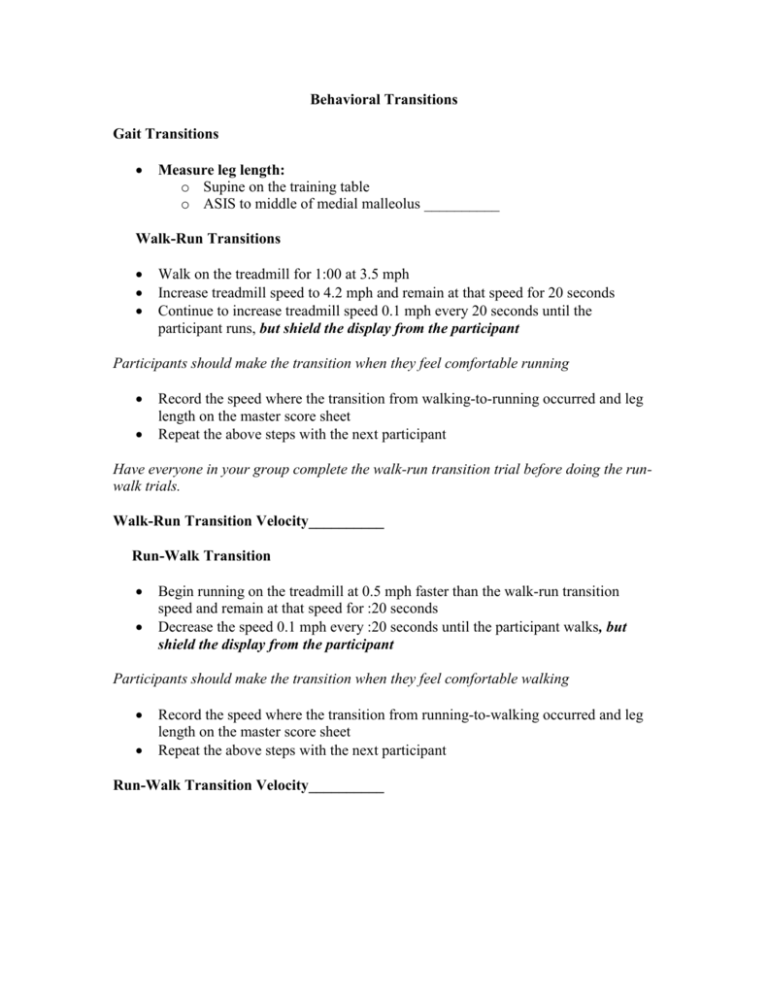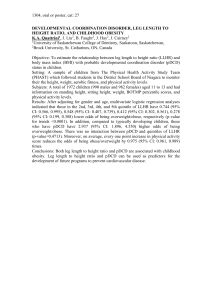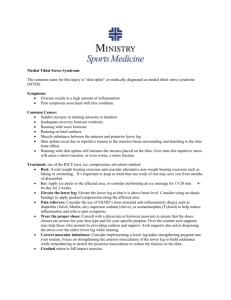Behavioral Transitions
advertisement

Behavioral Transitions Gait Transitions Measure leg length: o Supine on the training table o ASIS to middle of medial malleolus __________ Walk-Run Transitions Walk on the treadmill for 1:00 at 3.5 mph Increase treadmill speed to 4.2 mph and remain at that speed for 20 seconds Continue to increase treadmill speed 0.1 mph every 20 seconds until the participant runs, but shield the display from the participant Participants should make the transition when they feel comfortable running Record the speed where the transition from walking-to-running occurred and leg length on the master score sheet Repeat the above steps with the next participant Have everyone in your group complete the walk-run transition trial before doing the runwalk trials. Walk-Run Transition Velocity__________ Run-Walk Transition Begin running on the treadmill at 0.5 mph faster than the walk-run transition speed and remain at that speed for :20 seconds Decrease the speed 0.1 mph every :20 seconds until the participant walks, but shield the display from the participant Participants should make the transition when they feel comfortable walking Record the speed where the transition from running-to-walking occurred and leg length on the master score sheet Repeat the above steps with the next participant Run-Walk Transition Velocity__________ Affordance: Aperture Distance Measure shoulder width at the widest point Measure 125% of shoulder width from the wall to the shoulder of one of the testers Have the participant start at the doorway and walk fast through the opening between the wall and the tester Continue to reduce the distance between the wall to shoulder of one of the testers by 5% each trial until the person being tested rotates their shoulders Record the percentage where shoulder rotation occurred on the master score sheet Shoulder Rotation % __________ Affordance: Obstacle Height Measure lower leg length: o Seated on the training table o Measure mid-patella to middle of the medial malleolus__________ Hold a meter stick at a height that is 90% of lower length Have the participant walk fast toward the obstacle and as they approach it they must declare if they would “go over” or “go around”—they do not need to go over or go around, but should honestly declare what they would do Continue to increase the percentage height by 2% until participants declare that they would “go around”. Record the percentage height where participants declared they would “go around” on the master score sheet. “Go Around” %__________ Analysis Use SPSS to calculate the correlations between leg length: o walk-run transition velocity o run-walk transition velocity (consult the first lab on “General vs. Specific Motor Abilities” for directions on calculating and interpreting correlations) Calculate the mean and standard deviation for: o Aperture percentage o Obstacle Height percentage Questions 1. Are there significant relationships between leg length and either or both of the transition velocities? Explain your answer in statistical terms. 2. According to Mohler et al. (2007), what would happen to walk-run and run-walk transition velocities if optical flow rate was increased? Explain why this would happen. 3. Are the class results on aperture percentage consistent with the findings of experiment #1 in Warren et al. (1987)? Explain your answer. 4. Look at the figure below and read the caption underneath to determine if our class results are consistent with the findings of Patla (1997). Explain your answer. From Patla (1997) showing the relationship between obstacle height and lower leg length and the ratio where participants will “go over” or “go around”. 5. Aperture percentage and obstacle height percentage are tests of a concept called affordances. The idea of affordances originated with ecological psychologist, James J. Gibson, who believed that humans directly perceive body-scaled opportunities for movement in the environment. Direct perception implies that our judgments about what movement to make require minimal information processing because humans have co-evolved with their environment and, therefore their perceptual systems are attuned what type of action a particular environmental situation will allow. “Body-scaled” means we perceive are opportunities for movement in terms of the relationship between our body’s own dimensions and some environmental dimension. That is why you determined the ratio between aperture distance and shoulder width and lower leg length and barrier height because research has shown that behavioral changes (e.g., frontfacing-to-shoulder rotation or “go over”- to- “go-around”, etc.) occur when the relationship between human and environmental dimensions reaches some critical ratio (e.g., 100% of lower leg length, 130% of shoulder width, etc.). Describe two other situations where you think the relationship between a body and environmental dimensions represents an affordance. 6. Historical changes in sports techniques provide good examples of what can occur when individuals perceive the same environmental situation differently and recognize a new affordance. For example, from early 1890s to late 1940s shot putters stood sideways to throwing sector. In the late 1940s Parry O’Brien decided to turn his back to throwing sector and which increased the distance he could accelerate the shot and led to two consecutive Olympic gold medals. In the early 1970s Brian Oldfield used the discus spin to increase the acceleration distance even more and broke the world record with a 75 foot throw. Nowadays almost all elite shot putters use the discus technique. In the history of the shot put, the size of the throwing circle did not change, but shot putters discovered that it afforded different and more effective movements. Provide two examples of historical changes in sports techniques and explain why you think they represent the recognition of an affordance. 7. What do our lab results and the research findings indicate about the role perception plays in determining motor behavior? Bonus In their introduction Mohler et al. (2007) review several explanations for the walk-run transition, which one would predict that transition velocity would vary with leg length. Explain your answer.







